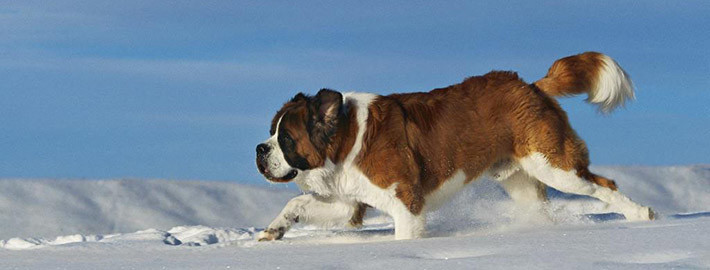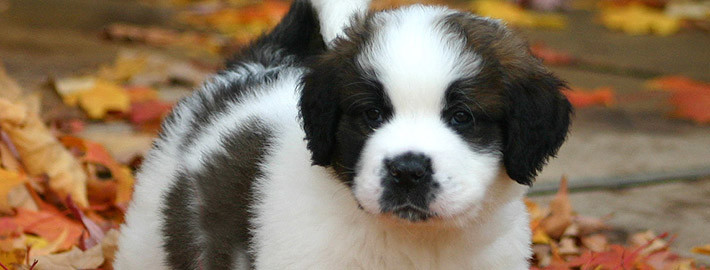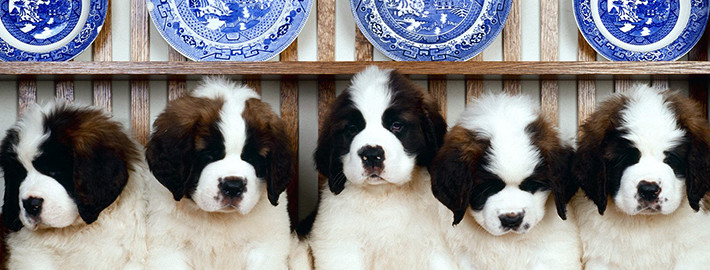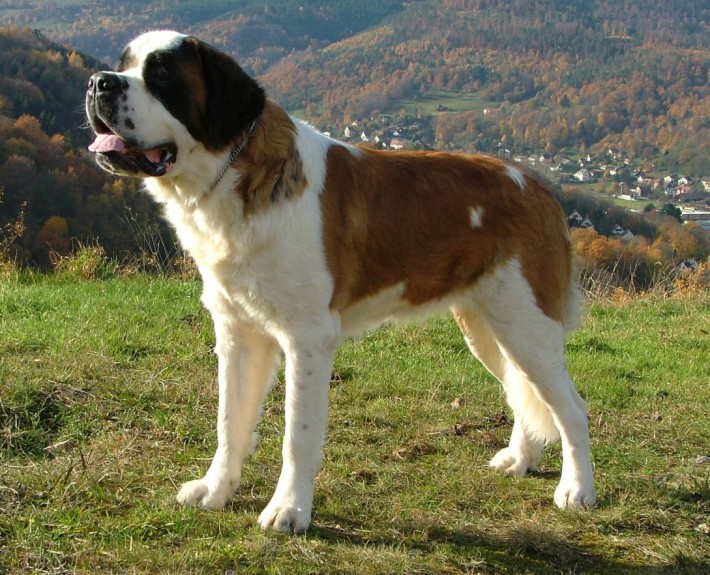What makes the Saint Bernard Unique?
The imposing Saint Bernard is powerful and proportionately tall. It is strong and well-muscled — necessary qualities in a dog that must trek through deep snow for miles. Its coat comes in two types: smooth, in which the short hair is very dense and tough, and long, in which the medium-length hair is straight to slightly wavy. Its expression should appear intelligent. The calm, easygoing Saint Bernard is gentle and patient around children, although it is not particularly playful. It is devoted to its family and is willing to please, although at its own pace. It can be stubborn.
Breed Groups
- Working Dog Breeds
- Extra Large Size
Page Contents
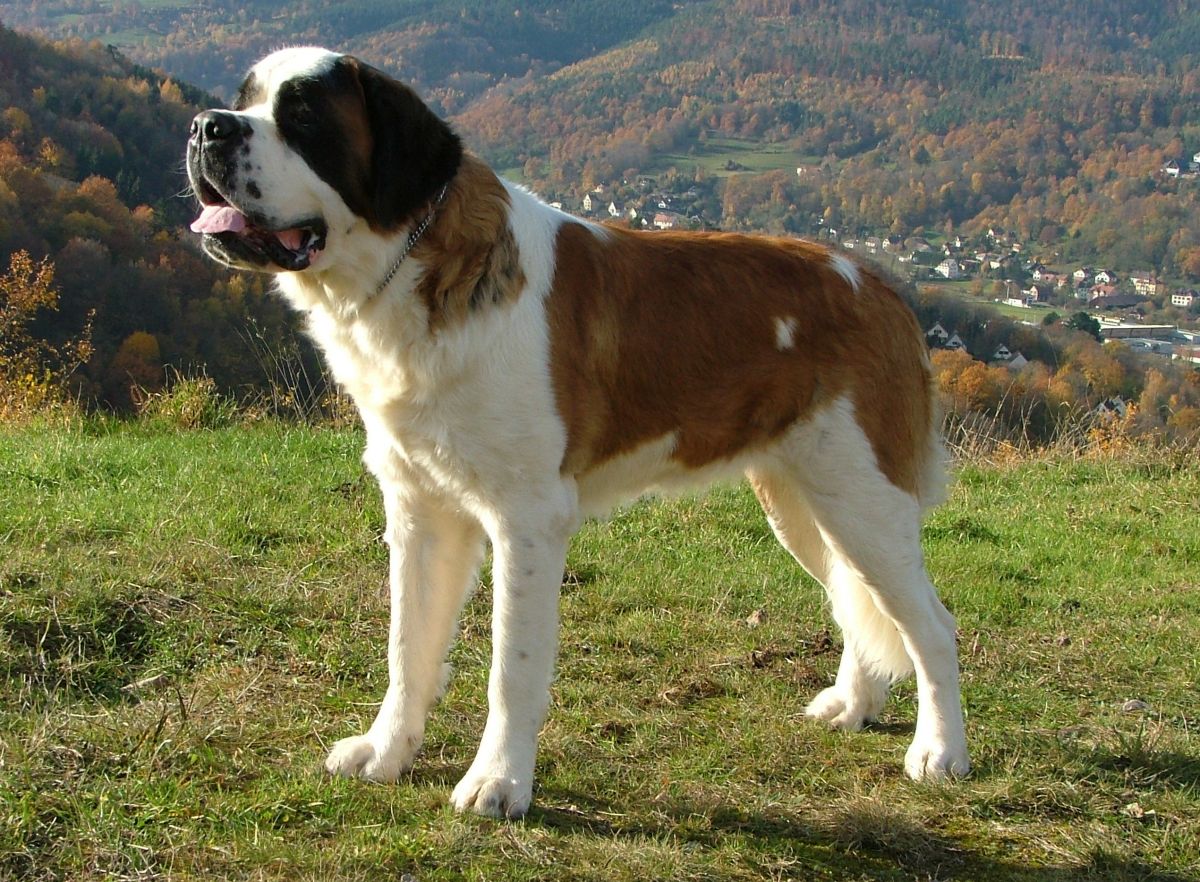
SnapShot
| Size: | Males – 28–35 inches (70–90 cm) Females – 26–31 inches (65–80 cm) |
| Weight: | Males – 140 to 180 pounds (63 – 81 kilograms) Females – 120 to 140 pounds (54 – 63 kilograms) |
| Origin: | Switzerland, Italy |
| Life Span: | 8 – 10 years |
| Colour: | Brindle & White, Brown & White, Mahogany & White, Orange & White, Red & White, Rust & White |
| Litter Size: | 6 – 8 puppies |
Is the Saint Bernard Right For You?
Both long-haired and short-haired Saint Bernards shed and need regular grooming. New owners should be prepared for drool – there is no such thing as a dry mouth Saint. This breed makes wonderful family companions with obedience training and daily exercise, but due to their larger size, may do better living in the country or suburbs. Learn more about purchasing a St. Bernard puppy. *Working Group; AKC recognized in 1885.
*Ranging in size from 25½ to 27½ inches tall at the shoulder and 130 to 180 pounds.
*Avalanche rescue.,
In 5 Words
- Lively
- Gentle
- Friendly
- Calm
- Watchful
Characteristics
Learn About the Saint Bernard
Description
General Appearance
Imposing yet lovable describes the appearance of the massive Saint Bernard. The head is broad with well-developed cheekbones, the muzzle is not tapered and a deep furrow runs from the muzzle attachment up between the eyes, finally blending into the occiput. The ears are medium in size, set high atop the head and stand away from the head at the base, with the flaps drooping towards the head. The teeth meet in a scissors bite. The nose is black, large and sports well-developed nostrils. The dark brown eyes are set front, are deep set and give the dog an air of friendliness and intelligence. The neck is thick and has a pronounced dewlap. The broad back is perfectly straight as far as the haunches where it then gently slopes to the rump. The tail is long and bushy and may be carried slightly bent upward. The coat comes in short and long varieties and may be red, red with white, or brindle with white.
Size and Weight
Males should stand a minimum of 27.5 inches at the shoulder and females should stand a minimum of 25.5 inches. They can range in weight from 120 to 180 pounds. The average weight for males is 170, and for females 160 pounds.
Coat and Color
Saint Bernards wear either short or long coats. The short coat is dense and smooth with slighly bushier hair on the thighs and long, dense hair covering the tail. The long coat is wavy, but never curly or shaggy. There is feathering on the forelegs and the thighs and tail are thick and bushy.
The coat comes in various shades of red with white or, conversely, white with red. The red shade can vary from brindle with white markings to a brownish-yellow color. White appears on the chest, as a collar around the neck, as a noseband, on the feet and at the tip of the tail. Desirable markings include a white spot on the nape of the neck and a white blaze on the face. A dark mask on the head and ears is also considered desirable
Short History of the Saint
Originating from the Roman Molossian dogs, the Saint Bernard developed into the impressive life-saving dog from 1660 to 1670. During this time, the first batch of these big dogs were brought to the St. Bernard Hospice, which was a refuge center for travelers moving between Switzerland and Italy. Originally, the breed helped in turning spits, pulling carts, and may have acted as companions or watchdogs, but soon the monks discovered that the dogs were exceptional pathfinders in snow. A Saint Bernard would track lost travelers, lick the lost person’s face, lie next to him to provide warmth, and help revive him. The dog served this prized role for more than 300 years and saved as many as 200 lives.
The most renowned of the St. Bernard dogs was Barry, who saved some 40 lives. Prior to this dog’s death, the Saint Bernard were known as “Hospice Dogs,” among other names. However, when the famous Barry died, the dogs were named Barryhund, after him.
In the early 19th century, numerous dogs died due to disease, severe weather, and inbreeding. In 1830, a few of those remaining were crossed with Newfoundlands, creating the first long-coated breed of the Saint Bernard variety. It appeared that long hair could protect the dog in very cold snow, but it was a hindrance as the snow stuck to the coat. Therefore, the long-haired varieties were not used for rescue work.
St. Bernards were exported into England in the mid-1800s, and were first referred to as the “Sacred Dog.” By 1865, the breed was commonly referred to as Saint Bernard, and was registered by the American Kennel Club in 1885. At this time, U.S. dog lovers took a fancy to the breed, making the Saint Bernard extremely popular by 1900. The dog remains one of the most popular giant breeds today.
Temperament
Saint Bernards are extremely gentle, friendly and very tolerant of children. They are slow moving, patient, obedient, extremely loyal, eager and willing to please. Be sure to socialize this breed very well at a young age with people and other animals. It is highly intelligent and easy to train; however, training should begin early, while the dog is still a manageable size. Teach this dog not to jump on humans starting at puppyhood. Bear in mind that an unruly dog of this size presents a problem for even a strong adult if it is to be exercised in public areas on a leash, so take control right from the start, teaching the dog to heel. The Saint Bernard is a good watchdog. Even its size is a good deterrent. They drool after they drink or eat. Be sure you remain the dog’s pack leader. Dogs want nothing more than to know what is expected of them and the St Bernard is no exception. Allowing a dog of this size and magnitude to be unruly can be dangerous and shows poor ownership skills. Saint Bernards have a highly developed sense of smell and also seem to have a sixth sense about impending danger from storms and avalanches.
Caring for Your Saint Bernard
General Health
The very fast growth rate and the weight of a St. Bernard can lead to very serious deterioration of the bones if the dog does not get proper food and exercise. Many dogs are genetically affected by hip dysplasia or elbow dysplasia. Osteosarcoma (bone cancer) has been shown to be hereditary in the breed.They are susceptible to eye disorders called entropion and ectropion, in which the eyelid turns in or out. The breed standard indicates that this is a major fault. The breed is also susceptible to epilepsy and seizures, a heart disease called dilated cardiomyopathy, and eczema.
US and UK breed clubs put the average lifespan for a St. Bernard at 8–10 years. A 2003 Danish breed survey (35 dogs) puts the median lifespan at 9.5 years while a UK breed survey in 2004 (53 dogs) puts the median lifespan at 7 years. In the UK survey about one in five lived to 10 years with the longest lived dog at 12 years and 9 months.
Grooming & Bathing
Both types of coat are easy to groom. Comb and brush with a firm bristle brush, and bathe only when necessary. Shampoo may strip the coat of its oily, water-resistant properties, so use a mild soap. The eyes, which may be inclined to water, need special attention to keep them clean and free of irritants. This breed sheds twice a year.
Exercise & Training
A long walk each day is needed to keep the Saint Bernard in good mental and physical condition. Puppies should not have too much exercise at one time until their bones are well formed and strong. Short walks and brief play sessions are best until the dog is about two years old.

